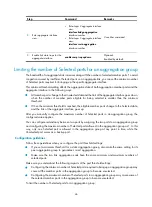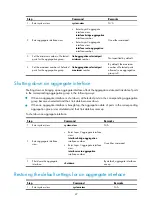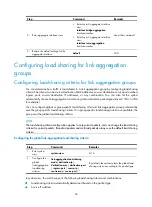
48
Step
Command
Remarks
2.
Enter aggregate interface view.
•
Enter Layer 2 aggregate interface
view:
interface bridge-aggregation
interface-number
•
Enter Layer 3 aggregate interface
view:
interface route-aggregation
interface-number
Use either command.
3.
Restore the default settings for the
aggregate interface .
default
N/A
Configuring load sharing for link aggregation
groups
Configuring load-sharing criteria for link aggregation groups
You can determine how traffic is load-shared in a link aggregation group by configuring load-sharing
criteria. The criteria can be source/destination MAC addresses, source/destination service port numbers,
ingress ports, source/destination IP addresses, or any combination. You can also let the system
automatically choose link-aggregation load-sharing criteria based on packet types (Layer 2, IPv4, or IPv6,
for example).
You can configure global or group-specific load-sharing criteria. A link aggregation group preferentially
uses the group-specific load-sharing criteria. If no group-specific load-sharing criteria are available, the
group uses the global load-sharing criteria.
NOTE:
The load sharing criteria configuration applies to only unicast packets, and can change the load sharing
criteria for unicast packets. Broadcast packets and multicast packets always use the default load sharing
criteria.
Configuring the global link-aggregation load-sharing criteria
Step
Command
Remarks
1.
Enter system
view.
system-view
N/A
2.
Configure the
global
link-aggregation
load-sharing
criteria.
link-aggregation load-sharing
mode
{
destination-ip
|
destination-mac
|
destination-port
|
ingress-port
|
source-ip
|
source-mac
|
source-port
} *
By default, the system selects the global load
sharing criteria according to the packet type.
In system view, the switch supports the following load-sharing criteria and combinations:
•
Load-sharing criteria automatically determined based on the packet type
•
Source IP address






























